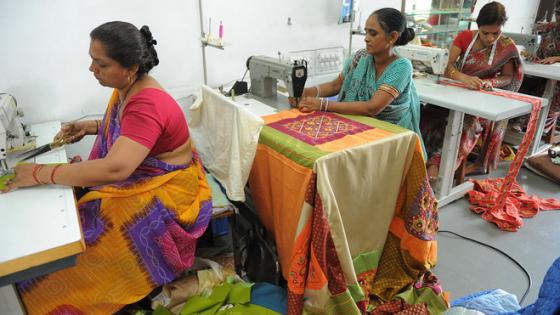India has carried out huge structural reforms to promote market competition and growth. It is now one of the fastest growing economies in the world. Has this also reduced gender discrimination, given the mounting concern that gender gaps are much bigger in India than in other developing countries? Theory, dating back to Gary Becker, suggests that competitive reforms should reduce the extent of this segregation (see also Weichselbaumer et al. 2007). Competitive forces should turn employment outcomes in favour of females because firms that incur an efficiency loss from discriminating against women are competed away from the market unless they change their hiring strategy. Since women offer cheap and flexible labour in many settings compared with men, greater competition should have induced feminisation of the workforce.
Unfortunately, empirical evidence suggests that market competition has not reduced gender segmentation in India. In recent work, we focus on the pattern of female activity and gender segmentation in the Indian manufacturing and services sectors (Ghani et al. 2016),. Although the share of women entrepreneurs and employees is larger in manufacturing than in services, segmentation based on gender is pervasive in both sectors. In spite of competition-inducing policy reforms, trade liberalisation, domestic reforms, and investment in physical and human infrastructure that India undertook since the turn of the century, gender-based segmentation has not subsided.
Investments in physical infrastructure had no effect on female activity and gender segmentation. Although there is some evidence of a negative correlation between segmentation among male employees and industry-level trade liberalisation reforms, overall it had a very limited impact on female participation in the labour force and in reducing segmentation among female employees. Domestic reforms that dismantled product reservations for small-scale industries induced greater participation among women in economic activity, and are correlated with a modest decline in segmentation among male employees. Segregation among female employees is positively associated with these reforms.
Structural transformation through a gender lens
Gender patterns by industry show that tobacco products, wearing-apparel, and textiles attract the largest count and share of women entrepreneurs in India, perhaps because globally these industries are known to impose lower requirements on physical labour. Among services, it is the education, sewage, refuse disposal, sanitation, and financial intermediation services that attract the largest share of female proprietors, and broadly also the largest count and shares of female employees.
The share of female-owned plants has increased both in the manufacturing and services sectors, but female activity is concentrated in the unorganised sector, with very little in the formal sector. The share of female-owned plants in the unorganised sector is much larger in manufacturing than in services. However, the output share of female-owned plants has remained low, hovering at around 8% and 6% in unorganised manufacturing and services, respectively.
Entrepreneurship, jobs, and gender segmentation
The gender composition of jobs has not changed much in India. The share of females in manufacturing employment has increased only marginally, but it has increased substantially in services. More female workers are finding services to be a better or more available employment avenue than manufacturing.
Are women entrepreneurs concentrated in low-paying industries? Empirical evidence suggests that there is a strong negative relationship between average industry wages and the share of industry in female-led plants in the unorganised sector. The concentration of female entrepreneurs in low-wage industries has grown over time. Women entrepreneurs in the unorganised manufacturing sector are more dominant in industries that pay lower average wages and the growth in women entrepreneurs is higher in such industries. By comparison, this association between the share of female-owned plants and average industry wages in the services sector is only mildly negative. But the differences between female entrepreneurs in high wage industries and those in low wage industries is narrowing in India.
There is a clear pattern of gender segmentation in both manufacturing and services. In the unorganised manufacturing sector, an average of 90% of employees in female-owned business are females, while this share is 81% in the case of services. Despite many competitive reforms that India has undertaken, this pattern of gender based segmentation has become more accentuated over the years. For instance, the share of female employees in female-led informal manufacturing plants increased from 88% in 2001 to 93% in 2010. In the case of services, the share of female employees in women-led establishments increased from 75% to 87% during the same period. Likewise, the share of male employees in male-owned businesses has increased from 80% to 86% in unorganised manufacturing.
Industries that show higher rates of female entrepreneurship and employment are also broadly the industries that show the highest segmentation in terms of female employees being matched to female owners. If people prefer to work with their own ‘types’ then in the case of India, the gender of the owner overwhelmingly predicts the gender of the employees. This is also true for male-led plants, where, for instance, radio, television, and communication equipment, other transport equipment, and fabricated metal products are among the most segmented in informal manufacturing. Meanwhile in the case of services, male-led plants in water transport, land transport, and research and development tend to employ the largest share of male workers. Although segmentation by gender is increasing in most industries, it is remarkably heightened in female-led plants in the basic metals and motor vehicles, trailers and semi-trailers segments of informal manufacturing, while within services it has increased the most in postal and telecommunications, and real estate services.
At the state level, Andhra Pradesh, Tamil Nadu, and West Bengal are amongst the states that have experienced the highest number and shares of female-owned plants in both manufacturing and services. The states with the lowest shares of female-owned plants are Assam and Bihar. It is surprising that the nation’s capital, Delhi, has the lowest share of female-owned establishments in manufacturing. Its position in the services sector is only slightly above the national average. Two out of the top four states with the highest count of women employed in manufacturing and services are from South India (Tamil Nadu and Andhra Pradesh).
Growth convergence through a gender lens
Has the gender gap across different states decreased or increased? States with higher incomes have displayed higher growth in shares of female-led plants. So, the gap in female-led plants has widened between the leading and lagging states in India. The states with higher employment of women or those with the highest shares of female-led plants are also among the most segmented when it comes to employing workers of the same gender.
Has gender segmentation across establishment sizes improved or worsened over time? Irrespective of whether segmentation is based on female-owned or male-owned establishments, it is larger for small plants. Segmentation is larger for an average male employee compared with an average female employee across all size bands – i.e. a male employee is more likely to be working with a male co-worker than a female employee is to be working with a female co-worker. This measure of segmentation is also at its peak in smaller plants, but for female employees it declines with increases in plant size up to mid-sized plants. Segmentation among male employees in manufacturing does not change much across the various size bands. In services, we observe a marginal but smooth decline across size bands in the services sector.
Urbanisation through a gender lens
How has urbanisation impacted female participation in economic activity? The share of female-owned businesses has declined with the increase in distance from the ‘Big 7’ cities in India. Female employment share has also declined with distance from the Big 7 cities in the services sector, while we do not observe any definitive spatial location pattern in the case of unorganised manufacturing. On the other hand, distance to Big 3 cities in India has not influenced the share of female activity, whether measured in terms of ownership share or employment share. Although gender segmentation is higher for female-owned plants than male-owned plants in the unorganised manufacturing sector and vice-versa for the services sector, we do not observe any decisive spatial pattern either with respect to the distance of districts from Big 7 or Big 3 cities.
Lessons and policy outcomes
India is simultaneously a leader in promoting women's participation in government but also a laggard in gender issues in the workplace. Its growth rate for manufacturing has been disappointing compared to its potential. Our work dissects many features of these gaps and also quantifies the linkages that exist. It helps understand which regulatory reforms are particularly effective in reducing gender segmentation, so that other regions within India, or nations outside of India, can learn how to make their efforts count the most. By way of such reforms, developing countries have an opportunity to not only improve the allocative efficiency of factors but also create an environment of equal opportunity and growth.
Gender-based segmentation has not subsided in India. India’s gender balance in entrepreneurship and jobs remains among the lowest in the world. Improving this balance is an important first step for India’s development and its achievement of greater economic growth and gender equality. While achieving economic equality sometimes requires tough choices (e.g. progressive taxation that may discourage effort), the opposite is true here.
Globalisation and trade policy have made a limited contribution towards India’s convergence in gender segmentation, while domestic pro-competitive reforms are strongly associated with lower segmentation among male employees. Thus, policies targeting the domestic competitive environment are perhaps more effective in mitigating discrimination in the labour market.
The international community, under the aegis of the United Nations, has been pursuing gender equality since 2000, which now features as one of the primary Sustainable Development Goals (SDGs). Empowering women to engage in productive employment is critical to achieving not only this SDG but is also pivotal to economic growth, poverty eradication, reducing child mortality, improving maternal health, and attaining universal primary education.
Gender is the new driver of economic growth in developing economies. This growth will come in many forms: increased female labour force participation, improved access to land and bank loans, and higher levels of political representation. Simply put, empowering half of the potential workforce has significant economic benefits beyond promoting gender equality.
References
Amin, M (2010), “Gender and informality”, World Bank Enterprise Note no. 16.
Bruhn, M (2009), “Female-owned firms in Latin America: Characteristics, performance, and obstacles to growth”, World Bank Policy Research Working Paper no. 5122.
Cagatay, N, and S Ozler (1995), “Feminization of the Labor Force: The Effects of Long-Term Development and Structural Adjustment”, World Development, 23 (11): 1883-1894.
Duflo, E (2012), “Women Empowerment and Development”, Journal of Economic Literature, 50(4): 1051–1079.
Ghani, E, A Grover, S Kerr, and W R Kerr (2016), "Will market competition trump gender discrimination in India?" Policy Research Working Paper Series 7814, World Bank.
Ghani, E, W Kerr, and S O'Connell (2013), “Local Industrial Structures and Female Entrepreneurship in India”, Journal of Economic Geography, 13(6): 929-964.
Ghani, E, W Kerr, and S O'Connell (2014), “Political Reservations and Women’s Entrepreneurship in India”, Journal of Development Economics, 108(C): 138-153.
Khera, P (2016), “Macroeconomic Impacts of Gender Inequality and Informality in India”, IMF Working Paper no. 16.
Rosenthal, S, and W Strange (2012), “Female Entrepreneurship, Agglomeration, and a New Spatial Mismatch”, Review of Economics and Statistics, 94(3): 764-788.
Weichselbaumer, D, R Winter-Ebmer, and M Zweimüller (2007), “What are the reasons for international gender wage gaps?”, VoxEU.org







